 Two moulded plastic chairs, one grey, one a sort of institution pinky orange, stood in front of Hilda’s spring; another lay on its side at a distance away, under a tree. The grey one was covered with flies. The chairs were that low budget, stacking sort: curved, with metal legs, and a cut out section at the base of the back which is, I suppose, designed to make lifting and stacking easier but which my young self, at primary school, believed to be a vent to let the farts out.
Two moulded plastic chairs, one grey, one a sort of institution pinky orange, stood in front of Hilda’s spring; another lay on its side at a distance away, under a tree. The grey one was covered with flies. The chairs were that low budget, stacking sort: curved, with metal legs, and a cut out section at the base of the back which is, I suppose, designed to make lifting and stacking easier but which my young self, at primary school, believed to be a vent to let the farts out.
There was something oddly touching about this scene: how it invited us to be modestly comfortable at the beginning of our pilgrimage; to take time to focus on what we were doing, and why. The water in the small pool was leaf-littered and a bit uninviting looking, but I leant down to dip my hands in the water under the little stone construction, where it actually “sprang”. It felt important.
Jenny and I made our way past a lovely row of mature, berry-heavy rowans, heading round the church towards the entrance and bumping into Ian the Churchwarden on the way. A delightful man who seemed thrilled to meet people walking the SHW, he made us very welcome, proudly showing us the swanky new church loo (always important in the C of E) and kitchen (a lot posher than mine) with its cupboards full of gleaming, matching William Morris mugs, and telling us about the various representations of Hilda around the church. 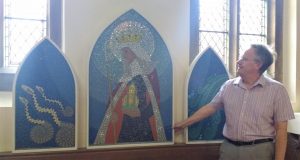 The mosaic triptych of Hilda had been a community art project in which the mosaic’s outlines were laid out by artists and filled in by locals who contributed their various bits and pieces in appropriate colours: a truly communal project, and a heart-lifting thing to hear about. He also showed us a painting of a proposed seating area in front of the spring—posher than the fart chairs, but still modest—but hinted that there might be Planning Issues. I hope the proposal gets through. Chair-wise, Hilda deserves better than she’s currently got.
The mosaic triptych of Hilda had been a community art project in which the mosaic’s outlines were laid out by artists and filled in by locals who contributed their various bits and pieces in appropriate colours: a truly communal project, and a heart-lifting thing to hear about. He also showed us a painting of a proposed seating area in front of the spring—posher than the fart chairs, but still modest—but hinted that there might be Planning Issues. I hope the proposal gets through. Chair-wise, Hilda deserves better than she’s currently got.
Ian pressed upon us a second copy of the SHW booklet, gave me his email address so I could let him know when the piece about the pilgrimage was posted (hello, Ian!) and left us to it. He’d struck exactly the right note: his pride in the church was quiet but evident, his talk perfectly judged—warm and informative without being overwhelming—and, crucially, there was no hint of that Kapital K Khristian vibe (you know the one) which can be so patronising and unappealing. The whole was one of those joyous encounters you couldn’t plan—indeed, wouldn’t have happened if we’d got the bus to Hinderwell, as we’d originally intended—and felt like a gift, a blessing at the beginning of our journey.
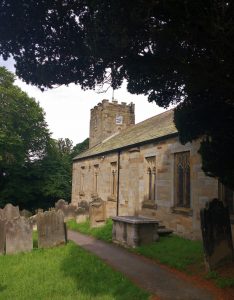 Time to leave the church and head through Hinderwell. Across the main road, down a couple of lanes, and then the first of those moments where we were to compare the OS map, the guide book and the OS app with an ok, what?? expression on our faces. It looked as though we should follow that track to the wood, but—where was the campsite marked on the map? In spite of its absence we decided to trust our instincts, and climbed over our first stile of the walk. Like many of the others on the route, it had a post whose top was fashioned into a smooth, pleasingly rounded, vaguely ecclesiastical shape. Very satisfactory.
Time to leave the church and head through Hinderwell. Across the main road, down a couple of lanes, and then the first of those moments where we were to compare the OS map, the guide book and the OS app with an ok, what?? expression on our faces. It looked as though we should follow that track to the wood, but—where was the campsite marked on the map? In spite of its absence we decided to trust our instincts, and climbed over our first stile of the walk. Like many of the others on the route, it had a post whose top was fashioned into a smooth, pleasingly rounded, vaguely ecclesiastical shape. Very satisfactory.
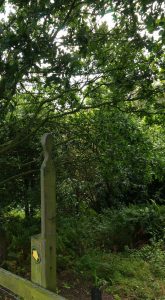 Ahead of us on the path was a large group of pheasants, parents and children, the children looking oddly out of balance without the long, adult magnificence of tail, and all of them running with that slightly ungainly, ostrich/extra from Jurassic park gait, their little legs working in panic and the bodies strangely still above them. These were the first of hundreds and hundreds of pheasants we were to see on the walk: so many families, enjoying their free range over the fields. It was the 6th August. Five days of safety left to them. “Why don’t they just stay still?” we both exclaimed, feeling sad about their impending doom. It was the panic-and-run thing that would get them into trouble. Hmm. Life lessons here, from pheasants?
Ahead of us on the path was a large group of pheasants, parents and children, the children looking oddly out of balance without the long, adult magnificence of tail, and all of them running with that slightly ungainly, ostrich/extra from Jurassic park gait, their little legs working in panic and the bodies strangely still above them. These were the first of hundreds and hundreds of pheasants we were to see on the walk: so many families, enjoying their free range over the fields. It was the 6th August. Five days of safety left to them. “Why don’t they just stay still?” we both exclaimed, feeling sad about their impending doom. It was the panic-and-run thing that would get them into trouble. Hmm. Life lessons here, from pheasants?
Wood; newly-mown pheasantful field; up, down. The weight of the pack on the uphill sections; gratitude for my staff to help distribute the work. We paused for breath and, checking with Nancy and John, our guides, were offered the gnomic instruction ‘Take care with navigation over the next section and avoid the temptation to stay low’. A couple of sentences later they added, ‘New waymarks should make this section easier’.
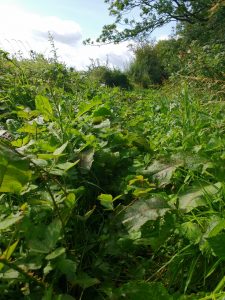 Now, what did all that mean? That the waymarkers were due to be installed, and would make things easier? That they had been, and did? That they weren’t installed, but should be? Whatever it meant, it was clear that this was a rarely-trodden section: face-high bracken and wildflowers; chest-high thistles. We were entering the Valley of the Nettles. I hadn’t anticipated this when I’d decided to wear shorts, but just had to plough through it, my legs soon becoming stung and scratched into a sort of numbness. Apart from that, this was all rather beautiful in a quietly English, undramatic sort of a way: a whole field full of tiny, cruciform, purple and white flowers; the brighter pinky purple of thistles;
Now, what did all that mean? That the waymarkers were due to be installed, and would make things easier? That they had been, and did? That they weren’t installed, but should be? Whatever it meant, it was clear that this was a rarely-trodden section: face-high bracken and wildflowers; chest-high thistles. We were entering the Valley of the Nettles. I hadn’t anticipated this when I’d decided to wear shorts, but just had to plough through it, my legs soon becoming stung and scratched into a sort of numbness. Apart from that, this was all rather beautiful in a quietly English, undramatic sort of a way: a whole field full of tiny, cruciform, purple and white flowers; the brighter pinky purple of thistles;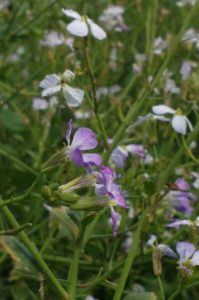 a lush, plentiful succulence of deep green leaves: and everywhere butterflies—admirals and painted ladies, white ones and brown ones and what Jenny informed me were Common Blues, which looked like tiny fluttering scraps of sky. Doing our best to ‘stay high’, we plunged and blundered. I felt blissful, alert, awake, alive: as if my whole being was one wide-eyed, delighted stare, drinking in all of life around me. This was it: this was the reset and refreshment I had been seeking.
a lush, plentiful succulence of deep green leaves: and everywhere butterflies—admirals and painted ladies, white ones and brown ones and what Jenny informed me were Common Blues, which looked like tiny fluttering scraps of sky. Doing our best to ‘stay high’, we plunged and blundered. I felt blissful, alert, awake, alive: as if my whole being was one wide-eyed, delighted stare, drinking in all of life around me. This was it: this was the reset and refreshment I had been seeking.
We startled a hare as we came to the edge of a slightly clearer, fescue-tussocky field, and watched it race away across the field’s full length. Pausing at the wall to have a bite of a peanut bar, we enjoyed a moment of knowing exactly where we were before turning right and plodding up the next field to a metalled lane which we followed to a bend, where we then cut across country again. I’d started the now-familiar thrash through high greenery when Jenny quietly said, “Um, I think that might be a path just to the left”. Oh yes. That’s easier. Along; cut between buildings where large, ectopic peacocks watched us from the wall before slipping away out of sight; along a minor road, and then a short unpleasant stumble along the uneven verge on the main road, where lorries and cars zoomed past, shoving air at us, assaulting our ears with the roar of engine, the grind of gears. Already these seemed like things from another existence. Horrible. We ducked into the car park at Scaling Dam Reservoir and walked along the embankment towards the other end. This was a straight and fairly joyless section: gusty wind, unappealing grey-brown choppy water, and the threat of rain in the air. This was simply Mission: lunch.
I was delighted to find that Jenny, too, enjoyed crisp sandwiches—I love the licence to eat anything that outdoor activity seems to offer—and we watched a pair of geese as we ate. One was limping: it was clearly in great discomfort, but the resulting walk was very camp and the effect was tragi-comic. Throwing them the last of the tasteless fluorescent cheese from our sarnies, we saddled up again—packs lighter, hip belts tighter!—and headed round the end of the reservoir and out past Boghouse Beck across Brown Rigg moor. 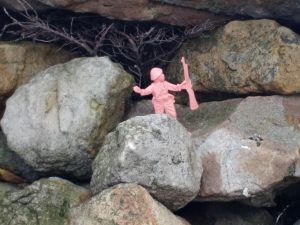 After the blare of traffic, suddenly we were in a different landscape: wide empty stretches of heathery moor, criss-crossed with deep tracks in the peat, the only sound the indignant grumble of grouse—enjoy the next 5 days, lovelies—who grumpily flew off as we approached. We passed a trio of small stone creations—not cairns exactly, or windbreaks, but something in between—each of which contained a tiny pink plastic soldier. I was fascinated: what was the story? How had they come to be here, and why? They were one of those lovely reminders of the vastness and variousness of life; that mine is one of a billion, billion stories; that we all have what Eliot calls ‘an equivalent centre of self, whence the lights and shadows must always fall with a certain difference’.
After the blare of traffic, suddenly we were in a different landscape: wide empty stretches of heathery moor, criss-crossed with deep tracks in the peat, the only sound the indignant grumble of grouse—enjoy the next 5 days, lovelies—who grumpily flew off as we approached. We passed a trio of small stone creations—not cairns exactly, or windbreaks, but something in between—each of which contained a tiny pink plastic soldier. I was fascinated: what was the story? How had they come to be here, and why? They were one of those lovely reminders of the vastness and variousness of life; that mine is one of a billion, billion stories; that we all have what Eliot calls ‘an equivalent centre of self, whence the lights and shadows must always fall with a certain difference’.
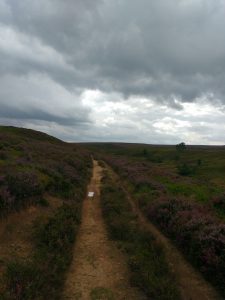 But the sky was darkening and filling, and just as we approached the Danby Beacon at the top of the moor, the highest point we would hit on our pilgrimage, the rain which had for some time been visibly reaching from sky to earth ahead of us finally hit us too. A scramble to get cags on, and I made the rookie error of not zipping mine up before I bent to put my rucksack’s inbuilt cag onto it, with the result that my jacket flipped inside out over my head and got satched on the inside, remarkably quickly. With my gammy shoulder I couldn’t reach round behind myself to pull it down and so did a sort of mad writhing on-the-spot caper to try to get it the right way out. It was that incredibly thorough, road-bouncy, blattery rain. Huddled at the top trying to get the guide book into the map case—“How many people does it take to get a book into a bag?” Jenny snarled in frustration—we saw a car full of Dutch people drive to the Beacon, sit there, engine idling, for about a minute, then drive off again. We made a half-hearted attempt to make a bit more of it ourselves but the rain was so ferocious that we couldn’t see anything—couldn’t even make out the info on the boards and “signage” available—so we splashed and squelched our way down the road towards Danby.
But the sky was darkening and filling, and just as we approached the Danby Beacon at the top of the moor, the highest point we would hit on our pilgrimage, the rain which had for some time been visibly reaching from sky to earth ahead of us finally hit us too. A scramble to get cags on, and I made the rookie error of not zipping mine up before I bent to put my rucksack’s inbuilt cag onto it, with the result that my jacket flipped inside out over my head and got satched on the inside, remarkably quickly. With my gammy shoulder I couldn’t reach round behind myself to pull it down and so did a sort of mad writhing on-the-spot caper to try to get it the right way out. It was that incredibly thorough, road-bouncy, blattery rain. Huddled at the top trying to get the guide book into the map case—“How many people does it take to get a book into a bag?” Jenny snarled in frustration—we saw a car full of Dutch people drive to the Beacon, sit there, engine idling, for about a minute, then drive off again. We made a half-hearted attempt to make a bit more of it ourselves but the rain was so ferocious that we couldn’t see anything—couldn’t even make out the info on the boards and “signage” available—so we splashed and squelched our way down the road towards Danby.
Ten minutes later the cags were off and we were in one of those newly-rinsed, pied sky sparkling landscapes that are particularly dazzling when you are walking.* We heard a curlew, then saw it flying, lower down in the valley, a distinctive brown speck against the green. Leaving the road, we passed under dripping oak trees—saw loads of oaks on this walk— following a ‘path’ which, Nancy and John asserted, ‘turns left down a steep slope and crosses Clither Beck at H’.
Yeah, right. No path, stepping stones or FB. Only face-high bracken and very, very slippery stones in the stream. I did one of those slo-mo slides from a stone into the beck, prevented from total immersion only by Jenny’s supporting arm and sheer combined strength of will. I was NOT going into this damn thing! Having crossed we found ourselves 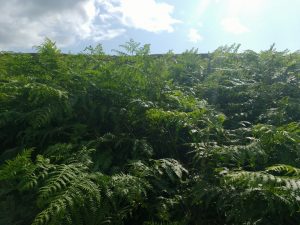 with more bracken blundering, and not even the magic arrow on the OS app could help us this time. When you find yourself deciding to climb a barbed-wire fence you know something has gone badly wrong with your nav. Ever resourceful, Jenny did a sort of Walter Raleigh number with the opened map over the top strand of wire, and with a consummate lack of grace I got myself over it unscathed. She followed. More consultation; even less clarity. Mutual sense of humour failure. Eventually we made for a gate into a farmyard, where a terrifying phalanx of dogs erupted, as one, from their kennels, barking furiously, in time to alert the farmer, who was just then chugging past on his tractor, that we were trespassing. The kennels were in cages, fortunately, but my heart was still hammering. “We can only apologise and say we’re lost,” I reassured myself several times, as we scuttled across the yard and onto the road. We turned right and, after a blessedly straightforward half a mile up a hill, found ourselves in Danby at last. There the welcoming arms of the Duke of Wellington awaited us, inviting us to settle in for the night. (I wonder how many people have ever said that?)
with more bracken blundering, and not even the magic arrow on the OS app could help us this time. When you find yourself deciding to climb a barbed-wire fence you know something has gone badly wrong with your nav. Ever resourceful, Jenny did a sort of Walter Raleigh number with the opened map over the top strand of wire, and with a consummate lack of grace I got myself over it unscathed. She followed. More consultation; even less clarity. Mutual sense of humour failure. Eventually we made for a gate into a farmyard, where a terrifying phalanx of dogs erupted, as one, from their kennels, barking furiously, in time to alert the farmer, who was just then chugging past on his tractor, that we were trespassing. The kennels were in cages, fortunately, but my heart was still hammering. “We can only apologise and say we’re lost,” I reassured myself several times, as we scuttled across the yard and onto the road. We turned right and, after a blessedly straightforward half a mile up a hill, found ourselves in Danby at last. There the welcoming arms of the Duke of Wellington awaited us, inviting us to settle in for the night. (I wonder how many people have ever said that?)
Whatever comforts the eponymous Duke may have offered his various lovers, this Duke was absolutely splendid. It was an old ivy-covered building of interesting angles and unexpected nook and crannies. It being my turn to have the better room, I soon made myself at home in the comfortable, double-bedded room where I did the settling-in 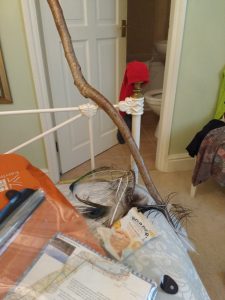 routines: shampooed my socks and pants, investigated the “vanity kit” (equals: three micro puffs of cotton wool, two cotton buds and a 5-by-1 cm piece of sandpaper disguised as an emery board). I stuffed my post-beck boots with newspaper which Grant, the kindly owner, had given me, pondered how best to dry my socks and settled for stretching them over the bedknobs. I made possibly the best cup of tea ever in the little teapot provided with the usual kettle and sachets (a genius addition), and had a shortish bath in the shortish bath tucked into the small bathroom, listening to a ferocious thunder and lightning storm and feeling very glad we weren’t out in it. My post- Valley of the Nettles legs were sore, red and throbbing (in a cartoon they would have had lines around them, to show this) and in the absence of any other unguent I covered them in bite cream and hoped for the best.
routines: shampooed my socks and pants, investigated the “vanity kit” (equals: three micro puffs of cotton wool, two cotton buds and a 5-by-1 cm piece of sandpaper disguised as an emery board). I stuffed my post-beck boots with newspaper which Grant, the kindly owner, had given me, pondered how best to dry my socks and settled for stretching them over the bedknobs. I made possibly the best cup of tea ever in the little teapot provided with the usual kettle and sachets (a genius addition), and had a shortish bath in the shortish bath tucked into the small bathroom, listening to a ferocious thunder and lightning storm and feeling very glad we weren’t out in it. My post- Valley of the Nettles legs were sore, red and throbbing (in a cartoon they would have had lines around them, to show this) and in the absence of any other unguent I covered them in bite cream and hoped for the best.
Then, wine and writing up my notes in the comfortable bar downstairs, where I listened to the locals talk and, when Jenny arrived, ordered a surprisingly delicious dinner: veggie haggis, neeps and tatties for me, lentil shepherd’s pie for Jenny. The chef was one of those insightful cooks who realises that, ideally, most finished dishes should be about 30% butter. Delicious. We spent a little more time in the tiny lounge between our rooms, where Jenny read in a lovely old armchair and I finished my notes at an antique, leather-topped desk. I enjoyed re-stuffing my left boot with the crumpled image of Donald Trump before giving my socks a blast with the hair dryer (Jenny really does have some inspired ideas) and collapsing into bed. There I reflected on how many ups and downs this one day had involved—about how, in this, pilgrimage is indeed a metaphor for life. I think Bunyan probably expressed this one a bit better…
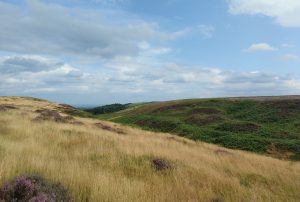
*Time for some more Hopkins: have a look here.
Danny is where my grandparents lived! I’ve been up Danby Beacon many a time
Ah hah! Meg from PP was brought up near here, too. She went to school in one of the places I’ll be writing about next time. Friends are everywhere…
So , can you tell me what the Beacon is about? It was too wet to read any of the info!
Enjoying your writing as ever. I did read the word peasants at first, and thought you were being very feudal, but realised they had tails…
Just had a frantic proofread, checking for ‘h’s. Phew!